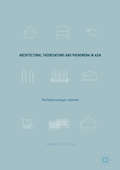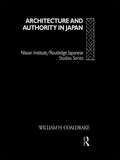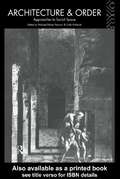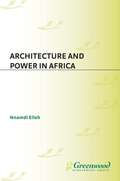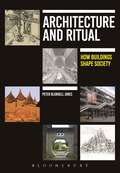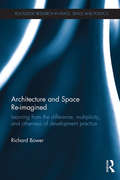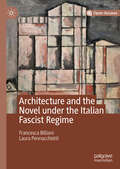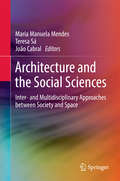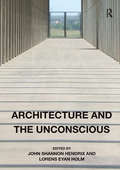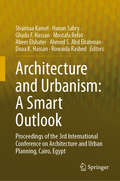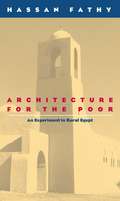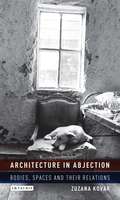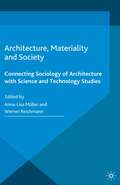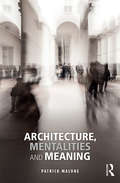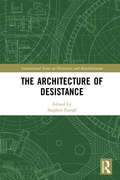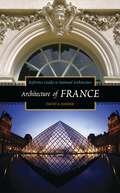- Table View
- List View
Architectural Theorisations and Phenomena in Asia: The Polychronotypic Jetztzeit
by Francis Chia-Hui LinThis book is the first overall and detailed discussion of contemporary Asia’s architectural theorisations and phenomena based on its heteroglossic and decolonisation character. Lin presents a theoretical journey of transdisciplinary reflection upon contemporary Asia’s pragmatic phenomena which is methodologically achieved by means of elaborations of how tangible Asian architecture can be philosophically theorised and how interchangeable architectural theory is practically ‘Asianised’. Discussions in the book are critically integrated with comparative studies focused on Japan, Taiwan, China, Hong Kong, Singapore, Malaysia, Australia, New Zealand and the UK. These empirical examinations are highlights of phenomenal localities, architecture, cities and cultures which reference the historicity of the Asia Pacific, Asia’s contemporary architectural situations, and their subtle relationship with the ‘West’. The schematisation of intended ‘fuzziness’ for Asia and its architecture is framed as the notion polychronotypic jetztzeit to represent a present time-place context of contemporary Asian architecture and urbanism. This book will be of great interest to scholars of Asian Studies, Architectural Studies, Postcolonial Studies, Urban Studies and Cultural Studies.
Architecture and Authority in Japan
by William H. CoaldrakeFirst published in 1996. Routledge is an imprint of Taylor & Francis, an informa company.
Architecture and Authority in Japan
by William H. CoaldrakeFirst published in 1996. Routledge is an imprint of Taylor & Francis, an informa company.
Architecture and Order: Approaches to Social Space (Material Cultures)
by Michael Parker Pearson Colin RichardsArchitecture is a powerful medium for representing, ordering and classifying the world, and understanding the use of space is fundamental to archaeological inquiry. Architecture and Order draws on the work of archaeologists, social theorists and architects to explore the way in which people relate to the architecture which surrounds them. In many societies, houses and tombs have encoded cultural meanings and values which are invoked and recalled through the practices of daily life.Chapters include explorations of the early farming r archi*eye of Europe, from before the use of metals, to the Classical and Medieval worlds of the Mediterranean and Europe. Research of the recent past and present include an overview of hunter-gatherers' camp organization, a reassessment of the use of space amongst the Dogon of West Africa and an examination of mental disorders relating to the use of space in Britain. The volume goes beyond the implication that culture determines form to develop an approach that integrates meaning and practice.
Architecture and Order: Approaches to Social Space (Material Cultures)
by Michael Parker Pearson Colin RichardsArchitecture is a powerful medium for representing, ordering and classifying the world, and understanding the use of space is fundamental to archaeological inquiry. Architecture and Order draws on the work of archaeologists, social theorists and architects to explore the way in which people relate to the architecture which surrounds them. In many societies, houses and tombs have encoded cultural meanings and values which are invoked and recalled through the practices of daily life.Chapters include explorations of the early farming r archi*eye of Europe, from before the use of metals, to the Classical and Medieval worlds of the Mediterranean and Europe. Research of the recent past and present include an overview of hunter-gatherers' camp organization, a reassessment of the use of space amongst the Dogon of West Africa and an examination of mental disorders relating to the use of space in Britain. The volume goes beyond the implication that culture determines form to develop an approach that integrates meaning and practice.
Architecture and Power in Africa (Non-ser.)
by Nnamdi EllehTwo of the most ambitious religious edifices of the 20th century are the Our Lady of Peace Basilica in the West African country of the Ivory Coast and the Hassan II Mosque in Morocco. Nnamdi Elleh not only provides a substantial architectural and pictorial analysis of the buildings themselves. Using these two buildings as case studies, he also investigates questions of national memory, urban form, architectural styles, concepts of democracy, social hierarchies as well as the elites who make the decisions to build Africa's post-independence monuments and capital cities. His book is an exciting synthesis of theoretical and empirical analysis that is bound to stimulate debate about the form and content of post-colonial identities in Africa.
Architecture and Ritual: How Buildings Shape Society
by Peter Blundell JonesArchitecture and Ritual explores how the varied rituals of everyday life are framed and defined in space by the buildings which we inhabit. It penetrates beyond traditional assumptions about architectural style, aesthetics and utility to deal with something more implicit: how buildings shape and reflect our experience in ways of which we remain unconscious.Whether designed to house a grand ceremony or provide shelter for a daily meal, all buildings coordinate and consolidate social relations by giving orientation and focus to the spatial practices of those who use them. Peter Blundell Jones investigates these connections between the social and the spatial, providing critical insights into the capacity for architecture to structure human ritual, from the grand and formal to the mundane. This is achieved through deep readings of individual pieces of architecture, each with a detailed description of its particular social setting and use. The case studies are drawn from throughout architectural history and from around the globe, each enabling a distinct theoretical theme to emerge, and showing how social conventions vary with time and place, as well as what they have in common. Case studies range from the Nuremberg Rally to the Centre Pompidou, and from the Palace of Westminster to Dogon dwellings in Africa and a Modernist hospital.In considering how all architecture has to mesh with the habits, beliefs, rituals and expectations of the society that created it, the book presents deep implications for our understanding of architectural history and theory. It also highlights the importance for architects of understanding how buildings frame social space before they prescribe new architectural designs of their own. The book ends with a recent example of user participation, showing how contemporary user interest and commitment to a building can be as strong as ever.
Architecture and Ritual: How Buildings Shape Society
by Peter Blundell JonesArchitecture and Ritual explores how the varied rituals of everyday life are framed and defined in space by the buildings which we inhabit. It penetrates beyond traditional assumptions about architectural style, aesthetics and utility to deal with something more implicit: how buildings shape and reflect our experience in ways of which we remain unconscious.Whether designed to house a grand ceremony or provide shelter for a daily meal, all buildings coordinate and consolidate social relations by giving orientation and focus to the spatial practices of those who use them. Peter Blundell Jones investigates these connections between the social and the spatial, providing critical insights into the capacity for architecture to structure human ritual, from the grand and formal to the mundane. This is achieved through deep readings of individual pieces of architecture, each with a detailed description of its particular social setting and use. The case studies are drawn from throughout architectural history and from around the globe, each enabling a distinct theoretical theme to emerge, and showing how social conventions vary with time and place, as well as what they have in common. Case studies range from the Nuremberg Rally to the Centre Pompidou, and from the Palace of Westminster to Dogon dwellings in Africa and a Modernist hospital.In considering how all architecture has to mesh with the habits, beliefs, rituals and expectations of the society that created it, the book presents deep implications for our understanding of architectural history and theory. It also highlights the importance for architects of understanding how buildings frame social space before they prescribe new architectural designs of their own. The book ends with a recent example of user participation, showing how contemporary user interest and commitment to a building can be as strong as ever.
Architecture and Space Re-imagined: Learning from the difference, multiplicity, and otherness of development practice (Routledge Research in Place, Space and Politics)
by Richard BowerAs with so many facets of contemporary western life, architecture and space are often experienced and understood as a commodity or product. The premise of this book is to offer alternatives to the practices and values of such westernised space and Architecture (with a capital A), by exploring the participatory and grass-roots practices used in alternative development models in the Global South. This process re-contextualises the spaces, values, and relationships produced by such alternative methods of development and social agency. It asks whether such spatial practices provide concrete realisations of some key concepts of Western spatial theory, questioning whether we might challenge the space and architectures of capitalist development by learning from the places and practices of others. Exploring these themes offers a critical examination of alternative development practices methods in the Global South, re-contextualising them as architectural engagements with socio-political space. The comparison of such interdisciplinary contexts and discourses reveals the political, social, and economic resonances inherent between these previously unconnected spatial protagonists. The interdependence of spatial issues of choice, value, and identity are revealed through a comparative study of the discourses of Henri Lefebvre, John Turner, Doreen Massey, and Nabeel Hamdi. These key protagonists offer a critical framework of discourses from which further connections to socio-spatial discourses and concepts are made, including post-marxist theory, orientalism, post-structural pluralism, development anthropology, post-colonial theory, hybridity, difference and subalterneity. By looking to the spaces and practices of alternative development in the Global South this book offers a critical reflection upon the working practices of Westernised architecture and other spatial and political practices. In exploring the methodologies, implications and values of such participatory development practices this book ultimately seeks to articulate the positive potential and political of learning from the difference, multiplicity, and otherness of development practice in order to re-imagine architecture and space. .
Architecture and Space Re-imagined: Learning from the difference, multiplicity, and otherness of development practice (Routledge Research in Place, Space and Politics)
by Richard BowerAs with so many facets of contemporary western life, architecture and space are often experienced and understood as a commodity or product. The premise of this book is to offer alternatives to the practices and values of such westernised space and Architecture (with a capital A), by exploring the participatory and grass-roots practices used in alternative development models in the Global South. This process re-contextualises the spaces, values, and relationships produced by such alternative methods of development and social agency. It asks whether such spatial practices provide concrete realisations of some key concepts of Western spatial theory, questioning whether we might challenge the space and architectures of capitalist development by learning from the places and practices of others. Exploring these themes offers a critical examination of alternative development practices methods in the Global South, re-contextualising them as architectural engagements with socio-political space. The comparison of such interdisciplinary contexts and discourses reveals the political, social, and economic resonances inherent between these previously unconnected spatial protagonists. The interdependence of spatial issues of choice, value, and identity are revealed through a comparative study of the discourses of Henri Lefebvre, John Turner, Doreen Massey, and Nabeel Hamdi. These key protagonists offer a critical framework of discourses from which further connections to socio-spatial discourses and concepts are made, including post-marxist theory, orientalism, post-structural pluralism, development anthropology, post-colonial theory, hybridity, difference and subalterneity. By looking to the spaces and practices of alternative development in the Global South this book offers a critical reflection upon the working practices of Westernised architecture and other spatial and political practices. In exploring the methodologies, implications and values of such participatory development practices this book ultimately seeks to articulate the positive potential and political of learning from the difference, multiplicity, and otherness of development practice in order to re-imagine architecture and space. .
Architecture and the Novel under the Italian Fascist Regime
by Francesca Billiani Laura PennacchiettiArchitecture and the Novel under the Italian Fascist Regime discusses the relationship between the novel and architecture during the Fascist period in Italy (1922-1943). By looking at two profoundly diverse aesthetic phenomena within the context of the creation of a Fascist State art, Billiani and Pennacchietti argue that an effort of construction, or reconstruction, was the main driving force behind both projects: the advocated “revolution” of the novel form (realism) and that of architecture (rationalism). The book is divided into seven chapters, which in turn analyze the interconnections between the novel and architecture in theory and in practice. The first six chapters cover debates on State art, on the novel and on architecture, as well as their historical development and their unfolding in key journals of the period. The last chapter offers a detailed analysis of some important novels and buildings, which have in practice realized some of the key principles articulated in the theoretical disputes.
Architecture and the Social Sciences: Inter- and Multidisciplinary Approaches between Society and Space
by Maria Manuela Mendes Teresa Sá João CabralThis book contributes to current debates on the relationship between architecture and the social sciences, highlighting current interdisciplinary and transdisciplinary teaching as well as research and practice in architecture and urbanism. It also raises awareness about the complementarities and tensions between the spaces of the project, including the construction spaces and living space. It gives voice to recent projects and socio-territorial interventions, focusing on interdisciplinary and multidisciplinary approaches between society and space. Divided into two parts, the first part discusses the possible dialogue between social sciences and architecture, while the second part explores architecture, politics and social change in urban territories from a European perspective.
Architecture and the Unconscious
by John Shannon Hendrix Lorens Eyan HolmThere are a number of recent texts that draw on psychoanalytic theory as an interpretative approach for understanding architecture, or that use the formal and social logics of architecture for understanding the psyche. But there remains work to be done in bringing what largely amounts to a series of independent voices, into a discourse that is greater than the sum of its parts, in the way that, say, the architect Peter Eisenman was able to do with the architecture of deconstruction or that the historian Manfredo Tafuri was able to do with the Marxist critique of architecture. The discourse of the present volume focuses specifically for the first time on the subject of the unconscious in relation to the design, perception, and understanding of architecture. It brings together an international group of contributors, who provide informed and varied points of view on the role of the unconscious in architectural design and theory and, in doing so, expand architectural theory to unexplored areas, enriching architecture in relation to the humanities. The book explores how architecture engages dreams, desires, imagination, memory, and emotions, how architecture can appeal to a broader scope of human experience and identity. Beginning by examining the historical development of the engagement of the unconscious in architectural discourse, and the current and historical, theoretical and practical, intersections of architecture and psychoanalysis, the volume also analyses the city and the urban condition.
Architecture and the Unconscious
by John Shannon Hendrix Lorens Eyan HolmThere are a number of recent texts that draw on psychoanalytic theory as an interpretative approach for understanding architecture, or that use the formal and social logics of architecture for understanding the psyche. But there remains work to be done in bringing what largely amounts to a series of independent voices, into a discourse that is greater than the sum of its parts, in the way that, say, the architect Peter Eisenman was able to do with the architecture of deconstruction or that the historian Manfredo Tafuri was able to do with the Marxist critique of architecture. The discourse of the present volume focuses specifically for the first time on the subject of the unconscious in relation to the design, perception, and understanding of architecture. It brings together an international group of contributors, who provide informed and varied points of view on the role of the unconscious in architectural design and theory and, in doing so, expand architectural theory to unexplored areas, enriching architecture in relation to the humanities. The book explores how architecture engages dreams, desires, imagination, memory, and emotions, how architecture can appeal to a broader scope of human experience and identity. Beginning by examining the historical development of the engagement of the unconscious in architectural discourse, and the current and historical, theoretical and practical, intersections of architecture and psychoanalysis, the volume also analyses the city and the urban condition.
Architecture and Urbanism: Proceedings of the 3rd International Conference on Architecture and Urban Planning, Cairo, Egypt
by Shaimaa Kamel Hanan Sabry Ghada F. Hassan Mostafa Refat Abeer Elshater Ahmed S. Abd Elrahman Doaa K. Hassan Rowaida RashedThis proceedings addresses the challenges of urbanization that gravely affect the world’s ecosystems. To become efficiently sustainable and regenerative, buildings and cities need to adopt smart solutions. This book discusses innovations of the built environment while depicting how such practices can transform future buildings and urban areas into places of higher value and quality. The book aims to examine the interrelationship between people, nature and technology, which is essential in pursuing smart environments that optimize human wellbeing, motivation and vitality, as well as promoting cohesive and inclusive societies: Urban Sociology - Community Involvement - Place-making and Cultural Continuity – Environmental Psychology - Smart living - Just City. The book presents exemplary practical experiences that reflect smart strategies, technologies and innovations, by established and emerging professionals, provides a forum of real-life discourse. The primary audience for the work will be from the fields of architecture, urban planning and built-environment systems, including multi-disciplinary academics as well as professionals.
Architecture for the Poor: An Experiment in Rural Egypt
by Hassan FathyArchitecture for the Poor describes Hassan Fathy's plan for building the village of New Gourna, near Luxor, Egypt, without the use of more modern and expensive materials such as steel and concrete. Using mud bricks, the native technique that Fathy learned in Nubia, and such traditional Egyptian architectural designs as enclosed courtyards and vaulted roofing, Fathy worked with the villagers to tailor his designs to their needs. He taught them how to work with the bricks, supervised the erection of the buildings, and encouraged the revival of such ancient crafts as claustra (lattice designs in the mudwork) to adorn the buildings.
Architecture for the Poor: An Experiment in Rural Egypt
by Hassan FathyArchitecture for the Poor describes Hassan Fathy's plan for building the village of New Gourna, near Luxor, Egypt, without the use of more modern and expensive materials such as steel and concrete. Using mud bricks, the native technique that Fathy learned in Nubia, and such traditional Egyptian architectural designs as enclosed courtyards and vaulted roofing, Fathy worked with the villagers to tailor his designs to their needs. He taught them how to work with the bricks, supervised the erection of the buildings, and encouraged the revival of such ancient crafts as claustra (lattice designs in the mudwork) to adorn the buildings.
Architecture in Abjection: Bodies, Spaces and their Relations (International Library of Architecture)
by Zuzana KovarThis book marks a turning point in architectural theory by using philosophy to examine the field anew.Breaking from the traditional dualism within architecture – which presents the body as subject and space as object – it examines how such rigid boundaries can be softened. Zuzana Kovar thus engages with complementary and complex ideas from architecture, philosophy, feminist theory and other subjects, demonstrating how both bodies and bodily functions relate deeply to architecture. Extending philosopher Julia Kristeva's notion of abjection – the confrontation of one's own corporeality as something is excreted – Kovar finds parallels in the concept of the 'scaffold.' Much like living bodies and their products can impact on the buildings that house them – old skin cells create dust, menstrual blood stains, our breath heats and cools surfaces – scaffolding is similarly ephemeral and yet not entirely separable from the architecture it supports. Kovar shifts the conversation about abjection towards a more nuanced idea of architecture – where living organisms, building matter, space, decay and waste are all considered as part of a continual process – drawing on the key informing works of thinkers like Gilles Deleuze and Felix Guattari to do this. Including a number of experimental projects conducted in the spaces inhabited by the author herself to illuminate the theory at its core, the book forms a distinguished and pioneering study designed for practitioners and scholars of architecture, philosophy and visual culture alike.
Architecture, Materiality and Society: Connecting Sociology of Architecture with Science and Technology Studies
by Anna-Lisa Müller Werner ReichmannThis book examines the extent to which the insights of STS can be used to analyse the role of architecture in and for social life. The contributions examine the question of whether architecture and thus materiality as a whole has agency. The book also proposes a theoretical and methodological approach on how to research architecture's agency.
Architecture, Mentalities and Meaning
by Patrick MaloneIn order to function, architectural theory and practice must be shaped to suit current cultural, economic, and political forces. Thus, architecture embodies reductive logic that conditions the treatment of human and social processes – which raises the question of how to define objectivity for architectural mentalities that must conform to a set of immediate conditions. This book focuses on meaning, and on the physical and mental processes that define life in built environments. The potential to draw knowledge from aesthetics, psychology, political economy, philosophy, geography, and sociology is offset by the fact that architectural logic is inevitably reductive, cultural, socio-economic, and political. However, despite the duty to conform, it is argued that the treatment of human processes, and the understanding of architectural mentalities, can benefit from interdisciplinary linkages, small freedoms, and cracks in a system of imperatives that can yield the means of greater objectivity. This is valuable reading for students and researchers interested in architectural theory as a working reality, and in the relationships between architecture and other fields.
Architecture, Mentalities and Meaning
by Patrick MaloneIn order to function, architectural theory and practice must be shaped to suit current cultural, economic, and political forces. Thus, architecture embodies reductive logic that conditions the treatment of human and social processes – which raises the question of how to define objectivity for architectural mentalities that must conform to a set of immediate conditions. This book focuses on meaning, and on the physical and mental processes that define life in built environments. The potential to draw knowledge from aesthetics, psychology, political economy, philosophy, geography, and sociology is offset by the fact that architectural logic is inevitably reductive, cultural, socio-economic, and political. However, despite the duty to conform, it is argued that the treatment of human processes, and the understanding of architectural mentalities, can benefit from interdisciplinary linkages, small freedoms, and cracks in a system of imperatives that can yield the means of greater objectivity. This is valuable reading for students and researchers interested in architectural theory as a working reality, and in the relationships between architecture and other fields.
The Architecture of Desistance (International Series on Desistance and Rehabilitation)
by Stephen FarrallThe volume of studies into desistance has grown dramatically in recent years. Much of this research has focused on the internal dynamics of desistance such as decision-making, choice and restraint. Bringing together leading figures and drawing upon case studies from around the world, this book seeks to fill a vacuum in the contemporary literature on desistance by considering processes and practices at a societal level that influence how and why people desist from crime. Beginning with an outline of what is known about how social, cultural and economic structures shape desistance from crime, this book proceeds to explore studies of desistance in countries such as the UK, Brazil, France, Israel, Ireland, Sweden and Chile. These studies touch on variations by ethnicity, the nature of the criminal justice system, economic cycles, gender, religious belief systems and the use of time and space. Policy matters relating to desistance such as the rehabilitation and supervision of former offenders are also explored. This book will be invaluable reading to students and scholars of criminology, sociology and social studies engaged in studies of desistance, criminology, criminal justice, victimology, penology and probation.
The Architecture of Desistance (International Series on Desistance and Rehabilitation)
by Stephen FarrallThe volume of studies into desistance has grown dramatically in recent years. Much of this research has focused on the internal dynamics of desistance such as decision-making, choice and restraint. Bringing together leading figures and drawing upon case studies from around the world, this book seeks to fill a vacuum in the contemporary literature on desistance by considering processes and practices at a societal level that influence how and why people desist from crime. Beginning with an outline of what is known about how social, cultural and economic structures shape desistance from crime, this book proceeds to explore studies of desistance in countries such as the UK, Brazil, France, Israel, Ireland, Sweden and Chile. These studies touch on variations by ethnicity, the nature of the criminal justice system, economic cycles, gender, religious belief systems and the use of time and space. Policy matters relating to desistance such as the rehabilitation and supervision of former offenders are also explored. This book will be invaluable reading to students and scholars of criminology, sociology and social studies engaged in studies of desistance, criminology, criminal justice, victimology, penology and probation.
Architecture of England, Scotland, and Wales (Reference Guides to National Architecture)
by Nigel R. JonesThe British terrain is a gold mine for the student of architecture. Ranging in era from ancient times to the present day—from Stonehenge to the Millennium Dome—this volume's 76 entries include palaces, castles, bridges, churches, country houses, and various public buildings and monuments, as well as such well-known features of British architecture and design as terraced houses, suburban semi-detached houses, and public telephone kiosks. Detailed yet accessible to nonspecialist readers, the alphabetical entries also provide cross-references and lists of additional information sources in both print and electronic formats. Appendixes list the entries by location, architectural style, and architect/designer; explain the defining characteristics of major British architectural styles; and discuss the importance of the Crown, peerage, and Parliament in British architectural history. Besides a detailed subject index, the volume includes a timeline, a general bibliography, a glossary of architectural terms, and an introduction that traces the development of British architecture from prehistoric and Roman times to the 21st century.Written by an associate professor of architecture at Oklahoma State University, Architecture of England, Scotland, and Wales, part of Greenwood's Reference Guides to National Architecture series, presents architectural biographies of these countries' most famous and significant structures.
Architecture of France (Reference Guides to National Architecture)
by David A. HanserCovering all regions of France—from Avignon's Palace of the Popes to Versailles' Petit Trianon—and all periods of French architecture—from the Roman theater at Orange to the Arc de Triomphe in Paris—this volume examines more than 60 of France's most important architectural landmarks. Writing in a clear and engaging style, David Hanser, professor of architecture at Oklahoma State University, describes the features, functions, and historical importance of each structure. Besides identifying location, style, architects, and periods of initial construction and major renovation, the cross-referenced and illustrated entries also highlight architectural and historical terms explained in the Glossary and conclude with a useful listing of further readings. The volume also offers ready-reference lists of entries by location, architectural style, and time period, as well as a general bibliography, a subject index, and a detailed introductory overview of French architecture.Entries cover major architectural structures as well as smaller sites, including everything from the Cathedral of Notre Dame to Metro (subway) stations. Ideal for college and high school students alike, this comprehensive look at the architecture of France is an indispensible addition to any shelf.
